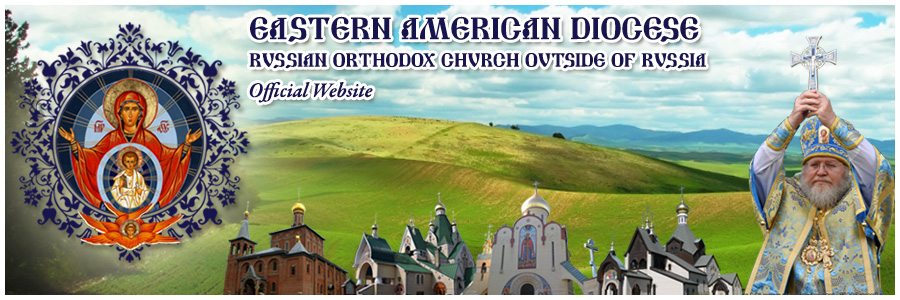
March 30, 2015
"A Pilgrimage along the Dniepr Banks" – An Interview with Bishop
Nicholas of Manhattan on his Visit to Ukraine
His Grace, Eastern American Diocesan vicar Bishop Nicholas of
Manhattan, spoke about his pilgrimage to Ukraine when he met with a
correspondent of the diocesan Media Office.
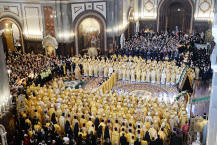 Last summer, after my consecration in California, Bishop Theodosius
of Seattle invited me to join him on a trip to Ukraine. I shared our
travel plans with Bishop George of Mayfield, who had yet to visit
Ukraine, and he decided to join us. This February, after celebrating
the sixth anniversary of His Holiness, Patriarch Kyrill’s,
enthronement, and participating in the Assembly of Bishops, we
departed by train from Moscow to Kiev.
Last summer, after my consecration in California, Bishop Theodosius
of Seattle invited me to join him on a trip to Ukraine. I shared our
travel plans with Bishop George of Mayfield, who had yet to visit
Ukraine, and he decided to join us. This February, after celebrating
the sixth anniversary of His Holiness, Patriarch Kyrill’s,
enthronement, and participating in the Assembly of Bishops, we
departed by train from Moscow to Kiev.
February in the Russian winter is a cold one. Two customs
checkpoints awaited us that night: at midnight, the Russian exit
checkpoint, which we cleared without any trouble. At three in the
morning, we arrived at the Ukrainian entry checkpoint. We said that
we were traveling with the intent to pray at the Kiev Caves Lavra.
And then, the woman checking our documents saw my passport with its
additional pages and said, "You’re quite the traveler, father." I
replied that I had traveled under obedience several times to Canada
and around Europe. The border guards were preparing to check one of
our bags, when a customs officer, checking in at their request, told
them to leave us monks alone. And so we continued on our way to the
holy sites of Kiev.
This was not your first visit. When did you first travel to Ukraine?
I first visited Ukraine in 2007 as a deacon, traveling with
Metropolitan Laurus after the signing of the Act of Canonical
Communion. It was a very short trip: we arrived in Kiev on May 23rd
and three days later, on the eve of Holy Pentecost, departed for
Pochaev.
The second time I was in Kiev was with the Kursk Icon in 2010. That
year, the Icon traveled for a week to All Saints Church outside of
the city, and I spent all of that time in obedience, guarding the
Icon in the church. This time, I was traveling to Ukraine in my new
capacity as a bishop, and I had a deep desire to interact with other
hierarchs, and peacefully pray at the holy sites of Kiev, for
myself, for the clergy, and for the parishioners of our Diocese.
We arrived in Kiev at around 9 o’clock in the morning. Bishop
Theodosius was ready to put together a itinerary with us to map out
our six-day visit, but it occurred to me, if possible, that we
should immediately visit His Beatitude Onufry, Metropolitan of Kiev,
and receive his blessing. Several days before, we met with him in
Moscow and let him know that we would like to meet and serve with
him in Kiev.
 How
did your pilgrimage begin?
How
did your pilgrimage begin?
We were informed that His Beatitude received guests during lunch in
his office in the Lavra, and Bishop George and I decided to go
there. Hardly a day goes by that Metropolitan Onufry does not
receive guests from among the clergy, people, even children – he
turns no one away. We waited for a little while, and when
Metropolitan Onufry arrived and saw us, he was overjoyed and said in
English, "What a nice surprise!" Turning to Bishop George, he said,
"Vladyka George, I am happy to see you!" Metropolitan Onufry simply
beamed. We were also glad to see him, and told him that we would
like to serve with him. His Beatitude showed us into his office and
listened intently as we spoke about our travels. Metropolitan Onufry
gifted us memorial panagias, and we thought that our interaction was
drawing to a close. But His Beatitude invited us to have lunch with
him. Joining us in the refectory was Metropolitan Mitrophan of
Lugansk & Alchevsk, chairman of the UOC’s Department for External
Church Relations, as well as some other priests. The Metropolitan
announced that guests had arrived from America, and blessed Priest
George Georgitsa to show us around Chernigov, Pochaev, and the
Kievan monasteries. Thus we obtained a tour guide to the holy sites
of Ukraine.
After lunch, Bishop George and I walked to the Near and Far Caves to
pray. This was not my first visit to the Lavra Caves, but I have to
say that the fear and trepidation of being there does not go away.
Bishop George, meanwhile, prayed there for the first time, and also
felt the same powerful grace. That evening, we informed Bishop
Theodosius about that pilgrimage plans that Metropolitan Onufry had
organized for us.
The following day, Fr. George came for us and we drove to Chernigov.
There, we visited Holy Trinity Cathedral, a monument to 17th century
architecture, where lay the relics of the saints of Chernigov: Holy
Hierarch Theodosius, Venerable Laurentius, and Archbishop Philaret
(Gumilevsky), who was glorified by the Ukrainian Orthodox Church in
2009. Our day was a busy one: Archbishop Ambrose of Chernigov &
Novgorod-Seversky showed us his diocesan cathedral, and later we
traveled to Holy Dormition Yeletsky Convent. This is one of the
oldest monasteries in Ukraine, and the oldest in Chernigov. The
convent was originally a men’s monastery, and was founded in the
middle of the 11th century by Prince Svyatoslav Yaroslavich in a
spruce forest, hence the name Yeletsky (which stems from the root
ель
(yel’), or spruce – trans.). According to monastery lore, the father
of Russian monasticism – Venerable Anthony of the Caves – was said
to have spent several years there. But most of the monastery’s
buildings were constructed in the 18th century. Among its abbots
were the renowned Church writer and distinguished figure in Church
history – the future Hierarch Demetrius of Rostov.
The monastery’s history has seen the invasion of the Mongol Tatars,
who sacked it in 1239; in the middle of the 17th century, it was
overtaken and run by Jesuits; at the end of 1921, it was closed, and
the current convent began its work in the early 1990s.
We also visited another of the remaining architectural monuments of
Kievan Rus’ – Chernigov’s Holy Transfiguration Cathedral (11th c.).
Its former glory is attested to by the remains of the frescoes, the
carved choir plates, and columns. Buried in Holy Transfiguration
Cathedral is Prince Igor Svyatoslavich the Brave, whose praises are
sung in the epic "Tale of Igor’s Campaign."
That evening, we dined with the sisters of Holy Dormition Convent,
and later returned to Kiev with wonderful impressions.
What did you think of the situation in Kiev?
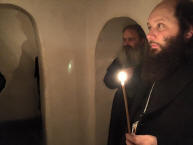 It
was calm in Kiev, but it was clear that the people were praying
especially fervently. When we served the All-Night Vigil in the
Refectory Church of the Kiev Caves Lavra, all of the hierarchs came
out for the Polyeleos, while Metropolitan Onufry remained to anoint
the faithful with oil, with Bishop George and me anointing on the
left and right sides of the church. There were many people, and we
anointed the faithful until the 9th Ode of the Canon – "More
Honourable than the Cherubim…"
It
was calm in Kiev, but it was clear that the people were praying
especially fervently. When we served the All-Night Vigil in the
Refectory Church of the Kiev Caves Lavra, all of the hierarchs came
out for the Polyeleos, while Metropolitan Onufry remained to anoint
the faithful with oil, with Bishop George and me anointing on the
left and right sides of the church. There were many people, and we
anointed the faithful until the 9th Ode of the Canon – "More
Honourable than the Cherubim…"
As people came up, we would congratulate them on the feast and the
Sunday, and it was clear that they were troubled, suffering,
yearning for peace and love, that the Lord reigned in the people’s
hearts, and that we were all brothers in Christ. We shared their
worries, but the fact that they came to church to pray for peace –
for communion with God – comforted, encouraged, and gave us hope.
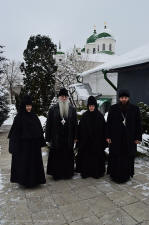 Your
Grace, you mentioned that Metropolitan Mitrophan of Lugansk was at
dinner with you. Lugansk is currently one of the dangerous hotspots…
Your
Grace, you mentioned that Metropolitan Mitrophan of Lugansk was at
dinner with you. Lugansk is currently one of the dangerous hotspots…
We did not have time to speak in detail. Metropolitan Mitrophan
mentioned that life in his diocese is currently very difficult,
asked our prayers, and added that, when he has to travel to and from
Lugansk, he has to take the long way around.
What holy sites in Kiev did you visit?
On Saturday, first we made our way to Holy Ascension-St. Florus and
Holy Protection Convents – medieval monasteries that were the only
ones to avoid closure by the godless authorities in the 1960s. In
the middle of the 18th century, Venerable Alexandra of Diveevo
(Mulgunov) – founder of St. Seraphim-Diveevo Convent – began her
monastic path in St. Florus (Florovsky) Convent. The monastery’s
primarily sacred object is a piece of the relics of the Holy Martyr Laurus.
In Holy Protection Convent, we spoke at length with Abbess
Callisthene and the sisters. They were very interested to hear about
church life in America and Australia, about the lives of Orthodox
parishes there. It turned out that the monastery had been visited by
pilgrims from Nyack, as well as Archpriest Victor Potapov from
Washington. It was comforting for us to hear that the nuns have not
ceased their monastic work, and zealously pray in the hope that the
Lord Jesus Christ and the Holy Prince Vladimir will hear their
prayers and send their help to the suffering Ukrainian people. The
nuns know of our saints and holy icons as well: the Holy Hierarch
John of Shanghai, the Kursk Icon of the Mother of God, and more; and
they asked our prayers.
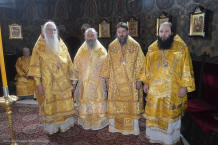 On
the Sunday of the Prodigal Son, the feast of the Holy New Martyrs &
Confessors of Russia, Bishops George and Theodosius and I served in
the Refectory Church of Venerable Anthony & Theodosius of the Caves.
Two choirs sang: the hierarchal choir and the monastic-seminary
choir. Metropolitan Onufry served, along with Metropolitan Paul (the
monastery’s deputy abbot), seminary rector Metropolitan Anthony, Bishop Clement of Irpen (vicar of the
Kievan Diocese), and us.
On
the Sunday of the Prodigal Son, the feast of the Holy New Martyrs &
Confessors of Russia, Bishops George and Theodosius and I served in
the Refectory Church of Venerable Anthony & Theodosius of the Caves.
Two choirs sang: the hierarchal choir and the monastic-seminary
choir. Metropolitan Onufry served, along with Metropolitan Paul (the
monastery’s deputy abbot), seminary rector Metropolitan Anthony, Bishop Clement of Irpen (vicar of the
Kievan Diocese), and us.
Before the service began, Metropolitan Paul approached us (he is a
longtime acquaintance of Bishop Theodosius’, who was tonsured in the
Lavra). He asked us to come more often and not to forget about
Ukraine, and promised to receive us joyfully and pray with us at the
Ukrainian holy sites.
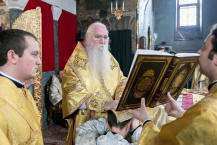 The
following day, at the appointed time during the Divine Liturgy,
Metropolitan Onufry asked Bishop George to perform that day’s
diaconal ordination, in order to confirm our brotherly unity.
"Bishop George, you will do the ordination," he said in English.
Metropolitan Onufry would take advantage of the slightest
opportunity to speak with us in English.
The
following day, at the appointed time during the Divine Liturgy,
Metropolitan Onufry asked Bishop George to perform that day’s
diaconal ordination, in order to confirm our brotherly unity.
"Bishop George, you will do the ordination," he said in English.
Metropolitan Onufry would take advantage of the slightest
opportunity to speak with us in English.
Upon completion of the service, Metropolitan Onufry invited us to a
luncheon at St. Panteleimon Convent, better known as "Theophania"
(the name of the historic garden to which it is adjacent – trans.).
His Beatitude told us how dear it was to him that we were here, that
we had come to prayerfully support the clergy and faithful of
Ukraine. And we thought, "It is good for us to be here!"
Returning home, we immediately called Metropolitan Hilarion and told
him about the ordination. Metropolitan Hilarion blessed this good
work, and expressed his gratitude to Metropolitan Onufry.
Your Grace, what were your impressions of your visit to Pochaev?
We traveled to Pochaev that same Sunday evening. On the way, we
visited Holy Trinity Convent in Korets. The abbess, Mother Raphaela,
showed us the convent’s holy icons and relics. I remember our last
visit there in 2007, and in one of the rooms I saw photographs on
the wall documenting our visit to the convent with Metropolitan
Laurus.
By the way, the convent has a chapel, wherein the "Unsleeping
Psalter" is read continuously.
We arrived in Pochaev after midnight. It was dark, frosty, snowy,
and quiet. We were greeted by the dean, Hieromonk Bessarion, and
Hierodeacon Theodore. Metropolitan Vladimir of Pochaev, deputy abbot
of the Lavra, was absent, but we did not lose hope that we would
meet with him.
 Holy
Dormition Pochaev Monastery is a special place for us. Here, the
future Archbishop Vitaly (Maximenko) labored before coming to
Jordanville. Our print shop, our singing, and our monastic
traditions all hail from here. This is the home of our sacred
Pochaev Icon of the Mother of God. As Metropolitan Laurus explained
to me, it was a gift to Archbishop Vitaly and Orthodox America from
Pochaev. The Icon was first kept at the Bronx cathedral. When the
Icon made its traditional annual visit to Jordanville for the Labor
Day Pilgrimage after Archbishop Nikon (Rklitsky’s) repose in 1976,
then-Archbishop Laurus left the Pochaev Icon at Holy Trinity
Monastery.
Holy
Dormition Pochaev Monastery is a special place for us. Here, the
future Archbishop Vitaly (Maximenko) labored before coming to
Jordanville. Our print shop, our singing, and our monastic
traditions all hail from here. This is the home of our sacred
Pochaev Icon of the Mother of God. As Metropolitan Laurus explained
to me, it was a gift to Archbishop Vitaly and Orthodox America from
Pochaev. The Icon was first kept at the Bronx cathedral. When the
Icon made its traditional annual visit to Jordanville for the Labor
Day Pilgrimage after Archbishop Nikon (Rklitsky’s) repose in 1976,
then-Archbishop Laurus left the Pochaev Icon at Holy Trinity
Monastery.
The following morning, Bishop George and I stepped outside, and the
cold was unbelievable. We even felt our bones freezing. But the
silence was so grace-filled. All around us lay snow, and the tree
with decorations still standing since Christmas. Holy Trinity
Cathedral stood before us, which Metropolitan Anthony (Khrapovitsky)
had consecrated. On weekdays, Midnight Office is served at 5 o’clock
in the morning in Holy Dormition Church, followed by the early
Liturgy in the Caves Church of Venerable Job. I noticed the
surprisingly kind faces of the monastics and pilgrims. It was the
dead of winter, and yet buses were pulling up full of tourists, and
the later Liturgy at 9 o’clock was packed to capacity.
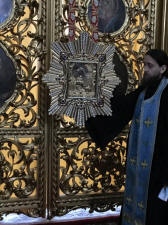 Listening
to the singing, I was reminded of Jordanville – our choir sings the
same way. I commemorated Metropolitan Laurus, Archimandrite Cyprian,
and other monastery brethren, and was comforted by memories of my
days in seminary and the time I had spent in the monastery. I
especially prayed for Archbishop Vitaly (Maximenko); although I did
not know him personally, I heard much about him from Metropolitan
Laurus. Hierodeacon Theodore told us about the monastery’s history,
about the frescoes in the church, and about monastery life. Later we
descended into the caves, where the relics of Venerable Job and
Amphilocius of the Caves rest. The monastery also has a cave where
Venerable Job labored when he was still alive. The monastery
currently has over 100 brethren, and the Lavra even hosts a
theological seminary.
Listening
to the singing, I was reminded of Jordanville – our choir sings the
same way. I commemorated Metropolitan Laurus, Archimandrite Cyprian,
and other monastery brethren, and was comforted by memories of my
days in seminary and the time I had spent in the monastery. I
especially prayed for Archbishop Vitaly (Maximenko); although I did
not know him personally, I heard much about him from Metropolitan
Laurus. Hierodeacon Theodore told us about the monastery’s history,
about the frescoes in the church, and about monastery life. Later we
descended into the caves, where the relics of Venerable Job and
Amphilocius of the Caves rest. The monastery also has a cave where
Venerable Job labored when he was still alive. The monastery
currently has over 100 brethren, and the Lavra even hosts a
theological seminary.
Upon our return from a trip to the parishes, Metropolitan Vladimir
greeted us. He was very interested in church life in America. Later,
we visited Holy Spirit Skete together, and there interacted with the
brethren.
We were fortunate enough to remain at Holy Dormition Pochaev Lavra
for several days, able to pray at the daily services. Metropolitan
Vladimir told us that, on feast days and Saturdays at the All-Night
Vigil, so many people will come that the crowds are anointed until
the end of the service.
On the day of our return to Kiev, we went to Holy Dormition
Cathedral for Midnight Office at 5 o’clock in the morning.
Metropolitan Vladimir invited us to pray in the altar. It was dark
in the altar, with only one candle burning on the altar table.
Through the darkness, we could hear the beautiful singing of the
monastery’s brotherhood choir.
I have heard that the monastery keeps a tradition relating to the
Pochaev Icon of the Mother of God. Is this so?
Yes. At the end of Midnight Office, the marvelous Pochaev Icon of
the Mother of God is lowered on sashes in front of the altar, while
the monks and pilgrims intone a special hymn to the Pochaev Mother
of God, the sticheron "Gate through which none may pass."
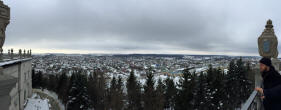 Metropolitan
Vladimir, Bishop George, and I stood before the Royal Doors on our
knees. Venerating the Icon, we proceeded to the relics of the
venerable saints in the cave church. The brethren remaining in the
church began to sing the akathist to the Pochaev Icon. In the lower
church, we venerated the relics of Sts. Job and Amphilocius. During
the Liturgy, I stood next to a window in the cave church and gazed
out at the gorgeous view of Pochaev from the mountain – sunrise,
winter, prayer…
Metropolitan
Vladimir, Bishop George, and I stood before the Royal Doors on our
knees. Venerating the Icon, we proceeded to the relics of the
venerable saints in the cave church. The brethren remaining in the
church began to sing the akathist to the Pochaev Icon. In the lower
church, we venerated the relics of Sts. Job and Amphilocius. During
the Liturgy, I stood next to a window in the cave church and gazed
out at the gorgeous view of Pochaev from the mountain – sunrise,
winter, prayer…
 There
we also met Bishop Job of Kashira, who serves in Canada, and
together with the clergy we served an akathist to the Venerable
Fathers.
There
we also met Bishop Job of Kashira, who serves in Canada, and
together with the clergy we served an akathist to the Venerable
Fathers.
Have any new traditions cropped up in the monastery – for instance,
special moleben hymns relating to the difficult challenges facing
the country?
Since last year, they have begun holy processions with the cross and
icons after evening services on Monday nights in the Lavra. The
brethren and pilgrims walk around the monastery – inside its walls –
in procession and pray that the Lord protect the monastery. I
decided to join them in procession. When the evening service
concluded, the senior priest came out with a cross, and eight monks
followed him out of the cathedral and around the monastery, followed
by about 300 pilgrims. As I was told later, there are far more
people in attendance in the summer. The faithful in the procession
walked quickly. Metropolitan Vladimir walked with us, while the
monks and pilgrims sang; at each of the stops, the clergy blessed
the monastery with the cross and icons. Our souls were overjoyed.
How are the Pochaev monks dealing with the atmosphere of division
and instability outside the monastery walls?
Metropolitan Vladimir explained to us that times are troubled, and
that the people are turning away from God, but many pilgrims still
come. One can see people paying more attention to themselves, to
entertainment, and very few of them think about their salvation. He
also noted that everything going on in Ukraine is a war against
Orthodoxy, against God. We noted in reply that the Orthodox in
America are also a small flock, and that it is not easy for us to
keep the youth within the Church. And we, as monks, must be an
example for them of men of prayer to God.
What other holy places did you visit before returning to Kiev?
 Before
returning to Kiev, we traveled through Kremenets. In St. Nicholas
Church at the Choirmaster School, we were met by our co-brother,
Metropolitan Sergius of Ternopol. During our meeting with the
students, we spoke about the scout camps in America, about our youth
conferences, about life in our parishes, about New York City, where
the Kursk Icon is kept and from whence it visits all around the
world. We spoke about the relics of St. John in San Francisco. The
students paid close attention, and some even had trouble believing
that there were Orthodox churches in America, too. Bishop George
spoke to the youth about Australia, where he will be moving after
Pascha, and explained that there are Orthodox Christians there, as
well. It was Cheesefare Week, and after the meeting I gave the
rector a humble contribution, and asked him to treat the students to
ice cream.
Before
returning to Kiev, we traveled through Kremenets. In St. Nicholas
Church at the Choirmaster School, we were met by our co-brother,
Metropolitan Sergius of Ternopol. During our meeting with the
students, we spoke about the scout camps in America, about our youth
conferences, about life in our parishes, about New York City, where
the Kursk Icon is kept and from whence it visits all around the
world. We spoke about the relics of St. John in San Francisco. The
students paid close attention, and some even had trouble believing
that there were Orthodox churches in America, too. Bishop George
spoke to the youth about Australia, where he will be moving after
Pascha, and explained that there are Orthodox Christians there, as
well. It was Cheesefare Week, and after the meeting I gave the
rector a humble contribution, and asked him to treat the students to
ice cream.
We also visited Holy Theophany Convent, where Metropolitan Sergius
showed us the church, while the abbess prepared us lunch. We
returned to Kiev spiritually overjoyed and contented.
 On
Wednesday, February 11, on the eve of our departure, we went once
more to pray at the Kievan Lavra. Our guide, Fr. George, showed us
the Lavra’s Holy Dormition Cathedral. At lunch, we met with Bishop
Jonah of Obukhov, who was present at my consecration in San
Francisco last summer. Bishop Jonah showed us around the Monastery
of the Mother of God "Joy and Comfort," metochion of Holy
Trinity-St. Jonah Monastery.
On
Wednesday, February 11, on the eve of our departure, we went once
more to pray at the Kievan Lavra. Our guide, Fr. George, showed us
the Lavra’s Holy Dormition Cathedral. At lunch, we met with Bishop
Jonah of Obukhov, who was present at my consecration in San
Francisco last summer. Bishop Jonah showed us around the Monastery
of the Mother of God "Joy and Comfort," metochion of Holy
Trinity-St. Jonah Monastery.
Bishop George was left with wonderful impressions, and expressed his
thanks for all of the brotherly love and support. Indeed, hierarchs
also experience moments of loneliness, but when you know that your
brother in Kiev, or in Australia or Seattle, is praying for you, and
you for him, then that unity in Christ is a great support.
We pray for our brothers in Ukraine; at every Liturgy we lift up
special petitions at the Augmented Litany and a prayer, in which we
ask God that lawlessness might cease and true love come to reign.
America is home to many Ukrainians. What can you tell them after
returning from Ukraine?
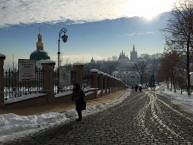 For
us, this pilgrimage was a grace-filled encounter with Kievan Rus’,
although using that phrase nowadays is not without some risk.
Standing on the high bank of the Dnieper River, St. Vladimir holds
aloft the cross, blessing not only Ukraine and Russia, but the
entire Orthodox world. We are all brothers in Christ, we share one
Orthodox Church, and we ought not spread disunity, but strengthen
our common prayer for the salvation of the Orthodox in America,
Russia, Ukraine, and in all the world.
For
us, this pilgrimage was a grace-filled encounter with Kievan Rus’,
although using that phrase nowadays is not without some risk.
Standing on the high bank of the Dnieper River, St. Vladimir holds
aloft the cross, blessing not only Ukraine and Russia, but the
entire Orthodox world. We are all brothers in Christ, we share one
Orthodox Church, and we ought not spread disunity, but strengthen
our common prayer for the salvation of the Orthodox in America,
Russia, Ukraine, and in all the world.
We experience difficulties, unhappiness – this is natural. We worry,
we pray, we make prostrations, but do we think about our salvation?
And if we – Ukrainians, Russians, Americans – all thought about our
salvation, this would immediately push us to united prayer for the
salvation of our souls. If we follow after Christ, then our
differences will fade into the background. Let us think about the
future: what do we want to leave to our children – a Church in
collapse, a divided Orthodox people who are constantly bickering, or
a united Church and peoples living in brotherly friendship and
prosperity? This is what the post-Christian world wants: to disrupt,
to divide, to destroy our Faith, our Church, our families, and our
holy places. Let us unite around Christ the Savior and show one
another and the whole world the Triumph of Orthodoxy. The Lord will
see our endeavor, our labors, and our unity – and will have mercy on
us.

Media Office of the Eastern
American Diocese

